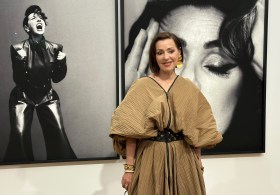Image via Shutterstock.
Whether you’re finishing your secondary school education and looking around for a university, or enrolling in an arts degree as a mature-aged student, finding ways to fund your education can be stressful. Scholarships – financial support awarded to a student, based on academic achievement or other criteria – are one means of making tertiary education more affordable. They also look superb on your CV.
Finding a scholarship that is suited to you – and which is offered at the school you are likely to attend – sounds like an impossibly daunting task, which is why we’ve made it easier for you.
Know your Scholarships
Researching the correct scholarship will save you time and eliminate opportunities that are not suited for your artistic study. Also bear in mind that some scholarships are very specific in regards to the applicants they want, Gillian Brown, Curator, Anne & Gordon Samstag Museum of Art, said that ‘The committee [that chooses the scholarship recipients] wants to see an artist thinking deeply about the next step for their practice.’
School leavers: Adelaide Central School of Art offers a School Leaver Scholarship for study related expenses after you complete secondary school. Anna O’Loughlin and Andrew Herpich from Adelaide Central School of Art said, ‘Our School Leaver Scholarship is merit-based. But academic achievement is certainly not the only factor. We consider the breadth of a person’s interests and experiences, including extracurricular activities, community contribution, and leadership skills.’
First year of study: There are some scholarships that will pay for your first year of study outright. JMC Academy offer eight Academic Undergraduate Scholarships that cover one academic year (two trimesters) of tuition fees.
Assistance throughout your study: The Western Australian Academy of Performing Arts (WAAPA) at Edith Cowan University (ECU) offer three scholarships and one is specifically aimed at supporting you throughout your study. The D’Arcy Slater Performing Arts Scholarship provides financial assistance paid over a three year period for applicants who are beginning their first year.
Last year of your education: The Chris Edmund Performing Arts Scholarship in partnership with WAAPA and MasterCard, through the Jackman Furness Foundation for the Performing Arts, is valued at $17,100 and was established to help provide financial assistant to third year Performing Arts students.
Post graduate travel and study: The Anne & Gordon Samstag International Visual Arts Scholarship Program provides students funding to study at an International school of the artist’s choice. ‘The scholarships are very generous and an incredible opportunity for an artist to build lasting professional relationships with international peers, curators and researchers,’ Brown said.
Unique scholarship opportunities: If you don’t fall under the usual categories, spending time searching for that unique opportunity will pay off in the long run. University of South Australia’s UniSA and Rising Sun Pictures Scholarship offers a full scholarship in either the Graduate Certificate in Compositing and Tracking or the Graduate Certificate in Dynamic Effects and Lighting.
Are you eligible?
Before you send that application letter, consider whether you are eligible to apply at all. Scholarships will provide a list of eligibility criteria which may be short or extensive, and the guidelines may stipulate that you must be able to prove you are: an Australian citizen, or an Australian permanent resident; enrolled in first year of the Bachelor of Arts or be enrolled in full time study.
And be aware that your application may hinge on an extra specific selection criteria. For example, Australian Film and Television (AFTRS) offer Equity Scholarships to assist disadvantage students for costs associated with study but you may have to fill out a Financial Hardship Form and be able to provide evidence of financial hardship.
Rebecca Taylor, Australian Scholarships Foundation, said: ‘Applicants who don’t follow the application instructions – such as failing to upload the required supporting documents or fully complete the application form – may be excluded from consideration. Additionally, applicants who are clearly ineligible will be discounted so it’s important to check the scholarship criteria. If you’re not sure, contact the scholarship provider.’
Pick up the phone and ask the school or funding body directly; you never know how flexible the Institution or guidelines may be. Some institutions offer guidance throughout the application process, Create NSW offers the Young Regional Artist Scholarship. On their website they state: ‘As soon as you begin an application, Create NSW will be in touch to provide information to help you plan your scholarship program and complete your application.’
Lachlan Herd from Create NSW said: ‘Some of the terminology can feel confusing or intimidating and financial planning can often be a totally foreign concept. It’s an invaluable experience to get your head around how these budget tables work and Create NSW can assist you in this.’
Herd also urged students to pick up the phone. ‘I strongly recommend getting in touch with us if you have any questions about budget tables and we can talk you through it. I would also recommend getting in touch with your art form service organisation, e.g. NAVA, Ausdance or MusicNSW, to get some guidance on the standards for fees and wages.’
Writing an application masterpiece: dos and don’ts
Now you know the scholarship you want to apply for, ensure you take your time to write a standout application.
Say no to cut and paste: Taylor said that you need to put some real time into compiling the paper work. ‘If asked for your objectives or expected outcomes from the scholarship, don’t simply copy and paste the advertised benefits. It’s important to apply the opportunity to your own situation and articulate your personal goals.’
Distinguish yourself: A photo-media artist working with digital and experimental formats, Jacqueline Felstead was awarded the illustrious 2017 Samstag Scholarship. She will be attending the Royal College of the Arts as part of her scholarship. From the perspective of an applicant, she said: ‘Knowing what distinguishes your practice in your field and communicating it,’ should be your number one priority.
Be specific not wordy: ‘Be specific [in your application] about how exactly the opportunity will further your art practice or research and be succinct,’ Felstead said. She also cautioned that applications should not be ‘unnecessarily lengthy or ignore selection criteria.’
Herd agreed. ‘If you believe your new musical production, art-making or filming will help you grow, connect and build your career then say why and how. Make sure the professional development benefits of your proposed activity are well articulated as this is what the panel will be looking for. Panel members are sector professionals but they aren’t psychic, they won’t know how valuable your project is to the development of your career unless you tell them!’
Don’t be late: Brown said, ‘They should not leave their application to the last minute! The Samstag Scholarship application process looks straightforward but as is often the case, simple tasks can be deceptively time-consuming. Application forms for the new rounds are made available online late January and close 30 June of every year. This is a comfortable enough time to compile an application and there is little that staff will be able to do to help at 4:55pm on closing day.’
Only send what is asked for: Herd said that too much irrelevant material is a waste of time for the judging panel and for the student. ‘Don’t overwhelm the panel with excessive support material, try not to include high school material (the panel wants to see you working independent of your studies) and most importantly don’t forget to read the guidelines and assessment criteria.’
Brown said: ‘With a large number of applications to review it is important to observe the given instructions regarding font size and image number limits.’
O’Loughlin and Herpich said that you shouldn’t waste your valuable time on unnecessary material. ‘Avoid including information that has not been requested in the application guidelines. For the assessment process to be equitable, additional information submitted by the applicant cannot be considered. It only serves to obscure the relevant information.’
Write with confidence: Felstead reminds applicants to ‘Write with confidence as you are the expert on your practice. A stiff upper lip is the prerequisite that everyone forgets to list, so if unsuccessful keep applying.’
Don’t be afraid to state what you are wanting, said Herd. ‘Strong support material, a detailed budget and a sense of enthusiasm,’ are vital.
‘Assume you are deserving of it! The choice to devote yourself to full-time study of visual art is an unusual one anyway, so if you have the necessary perquisites to apply, whatever you’ve done in your life up until that point must have contributed to that decision in some way,’ O’Loughlin and Herpich said. ‘Let some light in on your passion for art, your relationships with your communities, and your engagement with education.’
Scholarship after care
Once you have your scholarship money be aware that the taxman may also want a share of the funding. If you are a part-time student your scholarship may fall under taxable income, so ensure there are no surprises come July – head to the Australian Taxation Office’s website. The online tool, Is my scholarship taxable? will help you determine if you have to pay tax on your scholarship.
‘If you don’t get it on the first or second attempt, try again!’ said Taylor. ‘It’s easy to get discouraged by an unsuccessful result but often the key is to keep trying. By applying for multiple scholarships, it also shows that you are serious about the opportunity and about your career goals which is something scholarship providers are looking for!’





